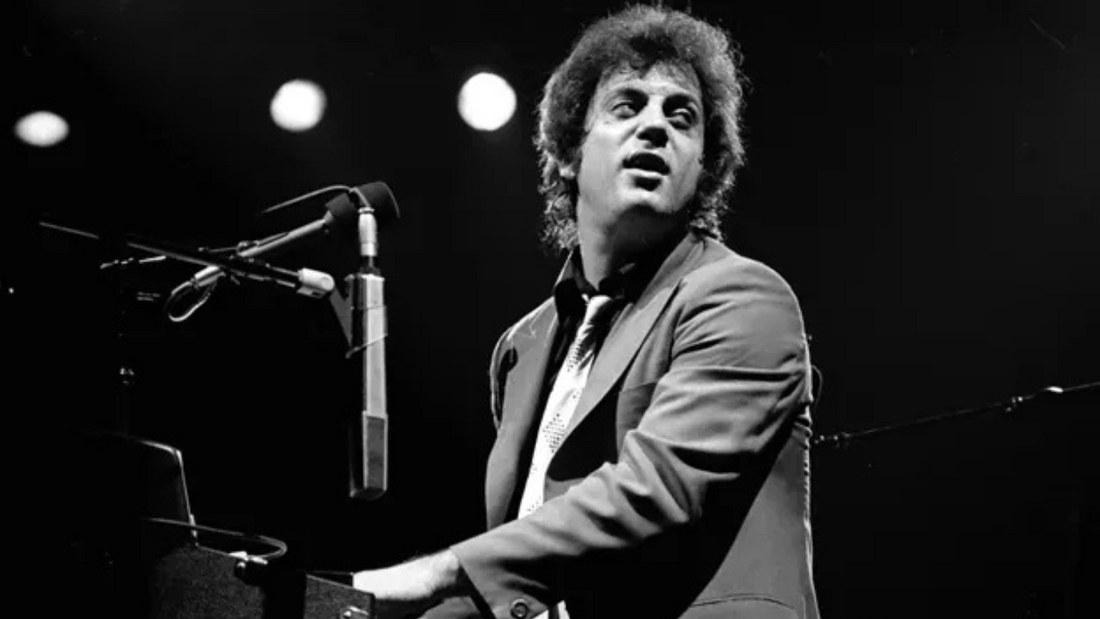
Piano Man by Billy Joel
Ellie WilkesShare
Piano Man is a classic folk-rock tale, and the first major commercial success for Billy Joel. Released on November 2nd, 1973, it tells the story of Joel’s time playing piano at a bar in Los Angeles, and the people he met there.
After his first album Cold Spring Harbor was badly produced by Family Productions, Joel signed on with Columbia Records, sparking a legal battle between the labels. He moved to LA to hide out while this unfolded, and worked as a pianist at the Executive Room bar under the name Bill Martin.
The six months he spent there inspired him to write Piano Man, a tale of people from different walks of life coming together to listen to him play and to “forget about life for a while”. His first wife Elizabeth also worked in the bar, and is honoured in the song as “the waitress practising politics”.
The song became his most enduring hit, Joel himself becoming known as the Piano Man.
 Pictured is a still from the Piano Man music video. Billy Joel sits looking down at the piano, wearing a brown coat, shirt and tie. A sparkly beaded curtain hangs behind him and reflects onto the timber table in the foreground. Two men sit on either side of him, one younger with long hair and glasses. He is facing away from the piano, toward the camera. The other is an older man, sitting with a drink and watching Joel play.
Pictured is a still from the Piano Man music video. Billy Joel sits looking down at the piano, wearing a brown coat, shirt and tie. A sparkly beaded curtain hangs behind him and reflects onto the timber table in the foreground. Two men sit on either side of him, one younger with long hair and glasses. He is facing away from the piano, toward the camera. The other is an older man, sitting with a drink and watching Joel play.
Despite being defined by the piano rhythm, this song can also sound great on guitar. Written in 3/4 time, a strong bass note starts every bar with two softer strums to follow. The main challenge is getting used to the changing bass notes.
This song uses a lot of chords that have a different bass note to their root note, and are written with a “/“. For example, the first line of the verse and chorus starts with a C Major Chord, before changing to a C/B, which is a C Major played with a B bass note, as shown in the chord sheet below.
These variations are crucial as they recreate the sound of the piano bass runs that give the song it’s distinct sound.
For C/E, the finger positions are the same as the C Major Chord, but the bass note is the open sixth, or E string.
 Pictured is a diagram of the C/E Chord. Played with your first finger on the second string first fret, second finger on the fourth string second fret, third finger on the fifth string third fret. The open sixth string creates the E bass note.
Pictured is a diagram of the C/E Chord. Played with your first finger on the second string first fret, second finger on the fourth string second fret, third finger on the fifth string third fret. The open sixth string creates the E bass note.
Different versions of the F Major Chord are used for different parts of the song. The F bar chord works best in the verses and choruses as the low F on the sixth string completes the bass run in this part of the song. When you get to the bridge, use the simpler version of F, which uses the first four strings and sounds better with the other chords in the bridge.
 Pictured is a diagram of the F bar chord. Played by barring the whole first fret with your first finger, second finger on the third string second fret, third finger on the fifth string third fret, fourth finger on the fourth string third fret. The sixth string first fret creates the F bass note.
Pictured is a diagram of the F bar chord. Played by barring the whole first fret with your first finger, second finger on the third string second fret, third finger on the fifth string third fret, fourth finger on the fourth string third fret. The sixth string first fret creates the F bass note.
 Pictured is a diagram of a simple F Chord. Played by barring the first two strings of the first fret with your first finger, second finger on the third string second fret, third finger on the fourth string third fret. The fourth string third fret creates the F root note.
Pictured is a diagram of a simple F Chord. Played by barring the first two strings of the first fret with your first finger, second finger on the third string second fret, third finger on the fourth string third fret. The fourth string third fret creates the F root note.
The bridge is followed by a nice bass run that leads the song back into the chorus. It is four bars of G, but the bass note changes with each bar. For this use the simple G, played with just the third finger on the first string, third fret. The first bar of the chorus completes this run nicely.
When strumming, aim for the higher strings to give the chords a bright sound that will contrast the bass notes nicely.
Give Piano Man a go today! It is a great song to sing along with friends and lots of fun to play!
Watch the full lesson here…
